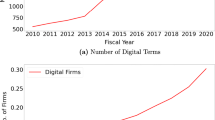Abstract
This paper computes (marginal and average) forward-looking effective tax rates for a sample of more than 650,000 firms in and outside of Europe using Bureau van Dijk’s ORBIS data-base. Comparing the firm-level effective tax rates with their country-level counterparts we arrive at two important findings for empirical research on the behavioral response to taxation. First, the firm-level component of the effective tax burden is generally much more important than the one at the country level. Second, tentative empirical results on the nexus between firm level investment and corporate taxation illustrate that the conclusions obtained with forward looking firm-level effective tax rates differ starkly from those based on country-level forward-looking rates.
Similar content being viewed by others
References
Auerbach, A. J. (1979). Wealth maximization and the cost of capital. Quarterly Journal of Eocnomics, 93, 433–446.
Blundell, R., Bond, S., & Meghir, C. (1996). Econometric models of company investment. In L. Matyas & O. Sevestre (Eds.), The econometrics of panel data: a handbook of the theory with applications (2nd edn.) (pp. 685–710). Boston: Kluwer Academic.
Buettner, T., & Ruf, M. (2007). Tax incentives and the location of FDI: Evidence from a panel of German multinationals. International Tax and Public Finance, 14, 151–164.
Commission of the European Community. (1992). Report of the committee of independent experts on company taxation, Brussels and Luxembourg.
Commission of the European Community. (2001). Towards an internal market without tax obstacles. A strategy for providing companies with a consolidated corporate tax base for their EU-wide activities, COM (2001) 582 final, Brussels.
Cummins, J. G., Hassett, K. A., & Hubbard, G. R. (1994). A reconsideration of investment behavior using tax reforms as natural experiments. Brookings Papers on Economic Activity, 2, 1–59.
Desai, M. A., Foley, C. F., & Hines, J. R. (2004). A multinational perspective on capital structure choice and internal capital markets. Journal of Finance, 59, 2451–2487.
Devereux, M. P. (2007). The impact of taxation on the location of capital, firms and profit: A survey of empirical evidence. Working Paper No. 07/02, Oxford University Centre for Business Taxation.
Devereux, M. P., & Freeman, H. (1995). The impact of tax on foreign direct investment: Empirical evidence and the implications for tax integration schemes. International Tax and Public Finance, 2, 85–106.
Devereux, M. P., & Griffith, R. (1998). Taxes and the location of production: evidence from a panel of US multinationals. Journal of Public Economics, 68, 335–367.
Devereux, M. P., & Griffith, R. (1999). The taxation of discrete investment choices. IFS Working Paper No. W98/16. London: Institute for Fiscal Studies.
Devereux, M. P., & Griffith, R. (2002). The impact of corporate taxation on the location of capital: a review. Swedish Economic Policy Review, 9, 79–102.
Devereux, M. P., & Griffith, R. (2003). Evaluating tax policy for location decisions. International Tax and Public Finance, 10, 107–126.
Devereux, M. P., Griffith, R., & Klemm, A. (2002). Corporate income tax: reforms and tax competition. Economic Policy, 35, 449–496.
Eisner, R., & Nadiri, M. I. (1968). Investment behavior and neo-classical theory investment behavior and neo-classical theory. Review of Economics and Statistics, 50, 369–382.
Hall, R. E., & Jorgenson, D. (1967). Tax policy and investment behavior. American Economic Review, 57, 391–414.
Hassett, K. A., & Hubbard, R. G. (2002). Tax policy and business investment. In A. J. Auerbach & M. Feldstein (Eds.), Handbook of public economics (Vol. 3, pp. 1292–1343). Amsterdam: Elsevier.
Jorgenson, D. W. (1963). Capital theory and investment behaviour. American Economic Review, 53, 247–259.
Jorgenson, D. W., & Siebert, C. D. (1968). A comparison of alternative theories of corporate investment behavior. American Economic Review, 58, 681–712.
Kemsley, D. (1998). The effect of taxes on production location. Journal of Accounting Research, 36, 321–341.
King, M. A. (1974). Dividend behavior and the theory of the firm. Economica, 41, 25–34.
King, M. A., & Fullerton, D. (1984). The taxation of income from capital. Chicago: University of Chicago Press.
Loretz, S. (2008). Corporate taxation in the OECD in a wider context. Oxford Review of Economic Policy, 24, 639–660.
McKenzie, K. J., Mansour, M., & Brule, A. (1998). The calculation of marginal effective tax rates, Technical Committee of Business Taxation Working Paper 97-15.
Moore, P., & Ruane, F. (2005). Taxation and the financial structure of foreign direct investment. The Institute for International Integration Studies Discussion Paper Series No. 88.
Mutti, J., & Grubert, H. (2004). Empirical asymmetries in foreign direct investment and taxation. Journal of International Economics, 62, 337–358.
Newey, W. K., & West, D. W. (1987). A simple, positive semi-definite, heteroskedasticity and autocorrelation consistent covariance matrix. Econometrica, 55, 703–708.
Organisation for Economic Cooperation and Development (OECD) (1991). Taxing profits in a global economy: domestic and international issues. Paris: Organisation for Economic Co-operation and Development.
Yoo, K.-Y. (2003). Corporate taxation of foreign direct investment income 1991–2001. OECD Economics Department Working Paper No. 365. Paris: Organisation for Economic Cooperation and Development.
Author information
Authors and Affiliations
Corresponding author
Rights and permissions
About this article
Cite this article
Egger, P., Loretz, S., Pfaffermayr, M. et al. Firm-specific forward-looking effective tax rates. Int Tax Public Finance 16, 850–870 (2009). https://doi.org/10.1007/s10797-009-9124-1
Received:
Accepted:
Published:
Issue Date:
DOI: https://doi.org/10.1007/s10797-009-9124-1




